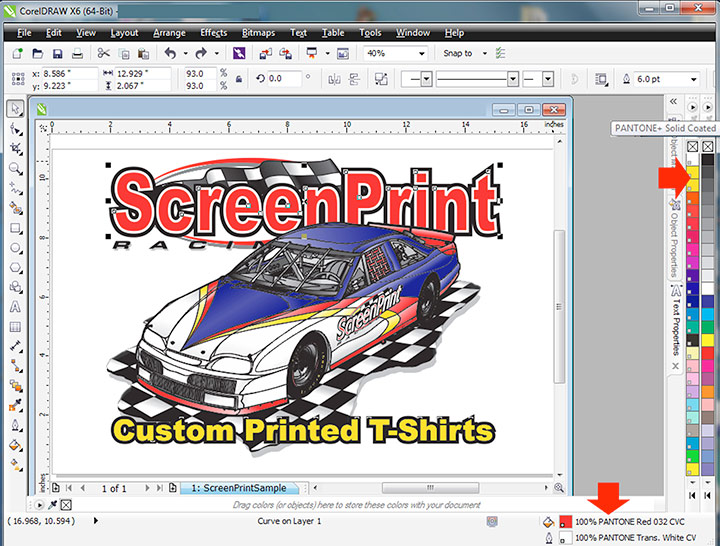One Click Cmyk Color Separation Software

What appears as ( ) in the top image is actually a blend of cyan, magenta, yellow and black, as magnification under a demonstrates.The CMYK color model (; process color, four color) is a, based on the, used in, and is also used to describe the printing process itself. CMYK refers to the four ink plates used in some color printing:, and(black).The CMYK model works by partially or entirely masking colors on a lighter, usually white, background. The ink reduces the light that would otherwise be reflected. Such a model is called subtractive because inks 'subtract' the colors red, green and blue from white light. White light minus red leaves cyan, white light minus green leaves magenta, and white light minus blue leaves yellow.In models, such as, white is the 'additive' combination of all colored lights, while black is the absence of light.
In the CMYK model, it is the opposite: white is the natural color of the paper or other background, while black results from a full combination of colored inks. To save cost on ink, and to produce deeper black tones, and dark colors are produced by using black ink instead of the combination of cyan, magenta, and yellow. Main article:With CMYK printing, (also called screening) allows for less than full saturation of the primary colors; tiny dots of each primary color are printed in a pattern small enough that humans a solid color. The same image, this time separated with maximum black, to minimize colored-inks use.The 'black' generated by mixing commercially practical cyan, magenta, and yellow inks is unsatisfactory, so four-color printing uses black ink in addition to the subtractive primaries.
Create individual CMYK separations To create individual separations in C, M, Y and K, the CLI call is rather simple: pdfToolbox -visualizer -format=images -part=sepprocess.
Common reasons for using black ink include:. In traditional preparation of color separations, a red keyline on the black line art marked the outline of solid or tint color areas.
In some cases a black keyline was used when it served as both a color indicator and an outline to be printed in black because usually the black plate contained the keyline. Comparison of some RGB and CMYK color gamut on a xy chromaticity diagram.Comparisons between displays and CMYK prints can be difficult, since the color reproduction technologies and properties are very different. A computer monitor mixes shades of red, green, and blue light to create color pictures.
A CMYK printer instead uses light-absorbing cyan, magenta, and yellow inks, whose colors are mixed using, or some other optical technique.Similar to monitors, the inks used in printing produce a color gamut that is 'only a subset of the visible spectrum' although both color modes have their own specific ranges. As a result of this, items which are displayed on a computer monitor may not completely match the look of items which are printed if opposite color modes are being combined in both mediums.
When designing items to be printed, designers view the colors which they are choosing on an RGB color mode (their computer screen), and it is often difficult to visualize the way in which the color will turn out post-printing because of this.Spectrum of printed paper To reproduce color, the CMYK color model codes for absorbing light rather than emitting it (as is assumed by RGB). The 'K' component absorbs all wavelengths and is therefore achromatic. The Cyan, Magenta, and Yellow components are used for color reproduction and they may be viewed as the inverse of RGB. Cyan absorbs Red, Magenta absorbs Green, and Yellow absorbs Blue (-R,-G,-B). Early representation of the three-color process (1902).Since RGB and CMYK spaces are both device-dependent spaces, there is no simple or general conversion formula that converts between them. Conversions are generally done through systems, using that describe the spaces being converted. An ICC profile defines the bidirectional conversion between a neutral 'profile connection' color space (CIE XYZ or Lab) and a colorspace we are interested in, in this case both RGB and CMYK. Omnisphere 2 keygen not working key.
The precision of the conversion depends on the profile itself, the exact methodology, and because the do not generally match, the and constraints such as ink limit.ICC profiles, internally built out of lookup tables and other transformation functions, are capable of handling many effects of ink blending. One example is the, which show up as non-linear components in the color-to-density mapping. More complex interactions such as Neugebauer blending can be modelled in higher-dimension lookup tables.The problem of computing a colorimetric estimate of the color that results from printing various combinations of ink has been addressed by many scientists. A general method that has emerged for the case of halftone printing is to treat each tiny overlap of color dots as one of 8 (combinations of CMY) or of 16 (combinations of CMYK) colors, which in this context are known as. The resultant color would be an area-weighted colorimetric combination of these primary colors, except that the Yule–Nielsen effect of scattered light between and within the areas complicates the physics and the analysis; empirical formulas for such analysis have been developed, in terms of detailed dye combination absorption spectra and empirical parameters.Standardization of printing practices allow for some profiles to be predefined. One of them is the US (SWOP), which has its ICC color profile built into many software including (as RSWOP.icm).See also. CMYK standard.References.
Campbell, Alastair. The Designer's Lexicon. 2000 Chronicle, San Francisco. P 192.
McCue, Claudia. Real World Print Production. 2007 Peachpit, Berkeley. P 31. Roger Pring (2000). Watson–Guptill. R.
Hodges (2003). John Wiley and Sons. Carla Rose (2003). Sams Publishing. Light-magenta light-cyan.
Damien van Holten, print international.org, 'RGB Vs CMYK'. ^ Gaurav Sharma (2003). CRC Press.External links Wikimedia Commons has media related to. —CMYK to RGB Calculator with source code. —animated illustration of RGB vs.